Alpine MAC ANSV Report: Ascending AS350B3 I-EDIC and Descending Jodel D.140E F-PMGV Collided Over Rutor Glacier
On 25 January 2019 Airbus Helicopters AS350B3 I-EDIC, operated by GM Helicopters, and Jodel D.140E F-PMGV of the Megève Aeroclub, collided in mid-air over the Rutor glacier, La Thuile, Italy. The mid-air collision (MAC), caught dramatically on video, occurred in Class G (i.e. uncontrolled) airspace while both aircraft operated under Visual Flight Rules (VFR). Five of the six occupants of the helicopter and two of the three occupants of the light aircraft were killed. One occupant from each aircraft miraculously survived, albeit seriously injured.
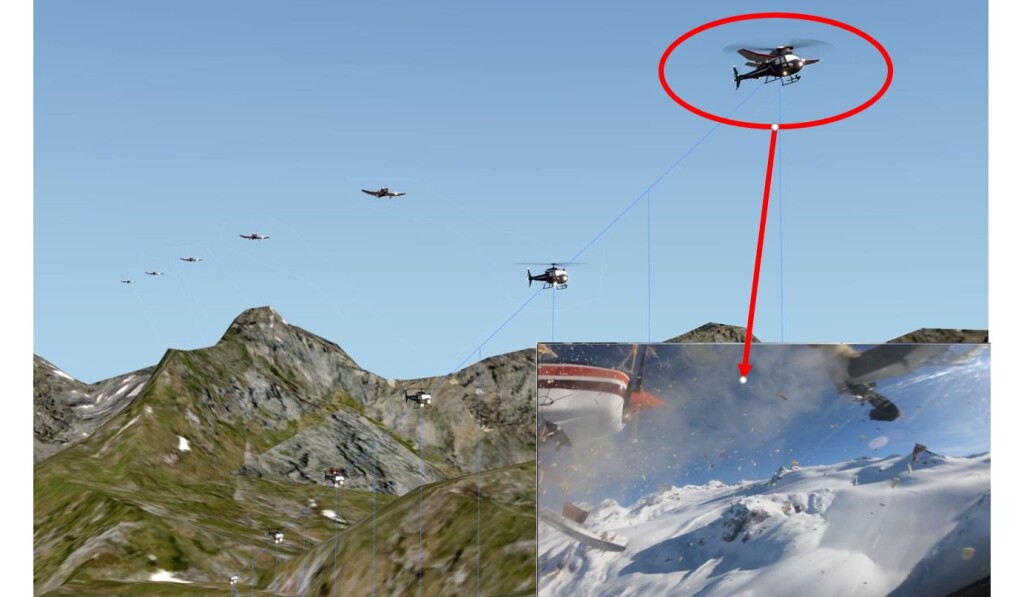
Mid Air Collision of AS350B3 I- EDIC and Jodel D.140E F-PMGV over Rutor Glacier, La Thuile (Credit: ANSV)
The Air Accident Flight
Italy’s Agenzia Nazionale per la Sicurezza del Volo (ANSV) explain in their safety investigation report, issued on the 11 June 2021, that the Jodel D.140E had taken off from Megève Altiport in France at 13:00 Local Time on a training flight, which was to include glacier landings. The flight instructor on board had over 16,000 hours of flying experience. The helicopter had picked up a party of skiers and their guide at 13:24 LT at Lago dei Seracchi-Cascate in Italy. The helicopter pilot had 7,120 hours of experience. At 13:25:36 hrs the two aircraft collided at an altitude of c 9,100 ft AMSL about 900 m within Italy. The wreckage was distributed over 250 m along a North-South axis.
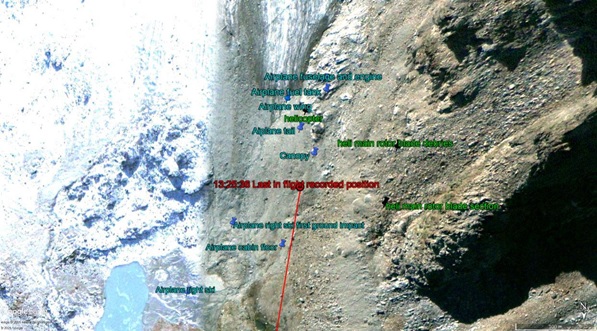
Wreckage Distribution AS350B3 I- EDIC and Jodel D.140E F-PMGV at Rutor Glacier, La Thuile (Credit: ANSV)
The helicopter was equipped with a Kannad 406 ELT. This did not activate.
ANSV Safety Investigation
Among the items recovered at the accident site were two GoPro cameras. One was installed on the right front windscreen of the helicopter and the other on the helmet of the mountain guide, seated on the left front seat of the helicopter.. The following are screenshots from the pilot camera video. They start at the take-off at Lago dei Seracchi and conclude at the impact.
Below are images from the mountain guide video at the time of impact:
Neither camera showed an indication of another aircraft until the impact. ANSV explain that:
An analysis of the environmental audio recorded by the pilot camera has been carried out. The audio recorded by the mountain guide camera was not usable. From this analysis it has been possible to deduce, with difficulty, due to the excessive signal strength associated with engine and main rotor noise compared to human voices, that during the 65 seconds between take off and collision, the pilot and the mountain guide have discussed some aspects of the landing site (Vedette del Rutor) and ground tracks; the same analysis has not revealed any radio calls made by the pilot or answered by him during that time.
Based on the videos, the distribution of the wreckage and the observed damage, the ANSV reconstructed the following impact dynamics:
While the helicopter was climbing from Lago dei Seracchi-Cascate (Superiore)…at an altitude of 2777 m AMSL, with a ground direction of 191°, and a GS of about 47 km/h, the collision took place in flight with the aeroplane, positioned a few feet higher than the helicopter and with a flight direction substantially similar to the latter.
The ANSV believe the Jodel aeroplane had most likely arrived in the area at 13:15 LT and after doing landing site recces was probably on final approach for its first glacier landing.
Based on GPS data…the helicopter’s climb rate in the last 30 seconds of flight was about 1200ft/min.
The initial impact was between the forward blade of the helicopter and the right main landing gear of the aeroplane, followed by subsequent impacts of the blades against the lower side of the aircraft fuselage and the ventral part of the right wing.
Reconstruction of the Moment of Impact of AS350B3 I- EDIC and Jodel D.140E F-PMGV over Rutor Glacier, La Thuile (Credit: ANSV)
The aeroplane broke up into several parts in flight; the helicopter, deprived of the front part of the cockpit, with one of the main rotor blades partially missing and the other two seriously damaged, went upside down in flight, and with such attitude impacted the ground.
The investigators comment:
It is worth noting that both aircraft, although operating in isolated mountainous areas and in class “G” class airspace, where often no assistance/flight information is available, were not equipped with on-board anti-collision systems or systems designed to detect the proximity of other aircraft. In the type of flight conducted by the two aircraft in question on the day of the accident, the principle of “see and avoid”, as well as the execution of self-information radio calls on the expected frequency, represent safety nets sometimes not sufficient to prevent in-flight collisions.
On these safety nets, some human factors (e.g. complacency, lack of attention, lack of perception, overload, task saturation during demanding manoeuvres, etc.) often have an effect, which may make them less effective than might be expected. A further “barrier” against possible in-flight collisions between aircraft operating under VFR could be the presence on board of systems capable of detecting the presence of other aircraft not acquired visually or through radio communications: in this regard, systems based on GPS receivers capable of calculating and transmitting the future position of the aircraft to other nearby aircraft equipped with similar systems, preventing the risk of possible collisions by sending alert messages to the respective crews, who thus become aware of the position of other aircraft with respect to the their own position. More advanced versions of such systems also provide the integration of an ADS-B receiver and transponder, which allows visibility on a greater number of aircraft among those that present a position and flight path with a risk of collision.
Systems such as those described above are present on a large number of general aviation aircraft; their presence on board, although constituting an additional safety net that has only an “alert” character, does not exempt pilots from the timely and careful application of the procedures and measures previously outlined (visual separation from other traffic and, in addition, self-information radio calls). In the present accident, the possible presence of systems similar to those described above on both aircraft would have allowed both crews to be aware of the presence of another aircraft operating in the Rutor area.
They go on to consider the human factors that affected the ability to see and avoid other traffic:
A common factor for both crews is the fact that, in the flight phases preceding the collision, the two aircraft had a flight path such that the sun was in an almost frontal position, which certainly influenced significantly the ability to perceive, even with peripheral vision, elements coming from other sectors than the frontal ones.
The wings and engine cowling of the Jodel reduced the pilot’s field of view and the helicopter, whose upper fuselage was painted dark blue, was in the shaded part of the valley till only just before the collision. In addition, the Jodel pilot’s attention was likely focused on the imminent glacier landing.
Meanwhile, the helicopter pilot was seated to the right, and tall (1.9 m / 6 ft 3 in), so his view in the direction of the Jodel would have also been poor.
Radio calls should have been made by both aircraft on 130.00 MHz. The ANSV concluded:
It is reasonably probable that there was no radio contact between the two aircraft…
They also note that the topology in that areas restricted communications with ATC when operating close to the ground.
The ANSV also comment the complexity of the Italian AIP.
The ANSV Determination of Cause
The accident, which consisted of an in-flight collision between the two aircraft, was caused by insufficient look-out activity by both crews, which should have been carried out it in a more incisive manner considering the restricted area and the critical flight phases in which both aircraft were operating.
The contributory factors were:
- The probable absence of bilateral radio communications.
- The limited or no visibility available to both crews towards the sector occupied by the other aircraft.
- The sun position, in front of both aircraft.
- The comprehensibility of Italian AIP.
- Megève Aeroclub landing on the glacier in violation of Italian national law.
Six safety recommendations were raised (three on the AIP, two safety promotion and one to EASA on electronic conspicuity).
Safety Resources
The European Safety Promotion Network Rotorcraft (ESPN-R) has a helicopter safety discussion group on LinkedIn.
The UK Airprox Board (UKAB) has released a video with tips for pilots on preventing mid air collisions:
There are six themes from previous incidents that the Board say: “can help cut the risks if pilots apply them every time they fly” (click on the image for more details):
You may also find these Aerossurance articles of interest:
- Mid-Air Collision of Guimbal Cabri G2 9M-HCA & 9M-HCB: Malaysian AAIB Preliminary Report
- AAIB Highlight Electronic Conspicuity and the Limitations of See and Avoid after Mid Air Collision
- Military Mid Air Collisions
- Military Airprox in Sweden
- North Sea S-92A Helicopter Airprox Feb 2017
- Mid Air Collision Typhoon & Learjet 35
- USMC CH-53E Readiness Crisis and Mid Air Collision Catastrophe
- Avoiding Mid Air Collisions: 5 Seconds to Impact
- Fatal Biplane/Helicopter Mid Air Collision in Spain, 30 December 2017
- A319 / Cougar Airprox at MRS: ATC Busy, Failed Transponder and Helicopter Filtered From Radar
- Merlin Night Airprox: Systemic Issues
- Alaskan Mid Air Collision at Non-Tower Controlled Airfield
- UPDATE 18 June 2022: Limitations of See and Avoid: Four Die in HEMS Helicopter / PA-28 Mid Air Collision

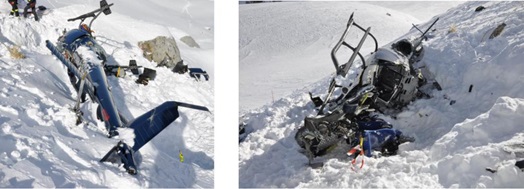

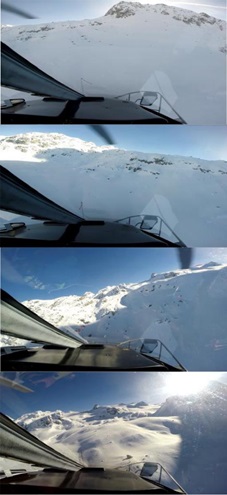
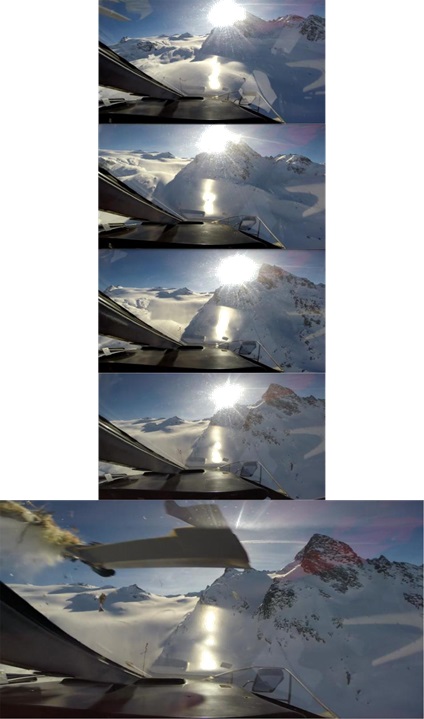
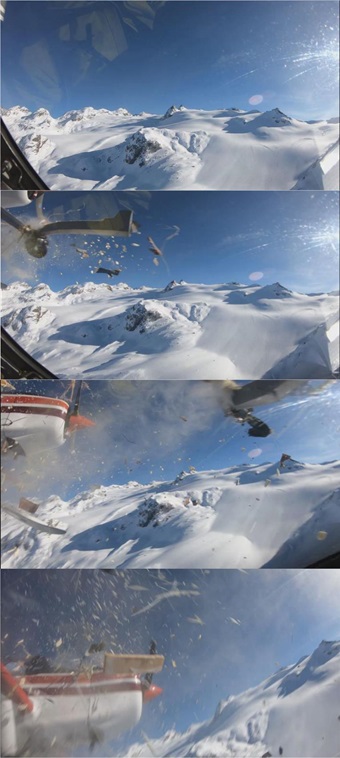


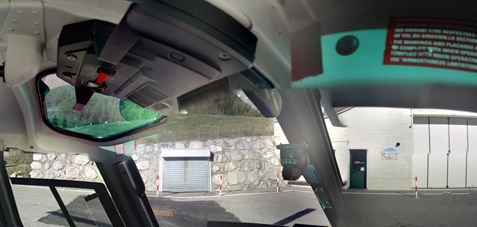
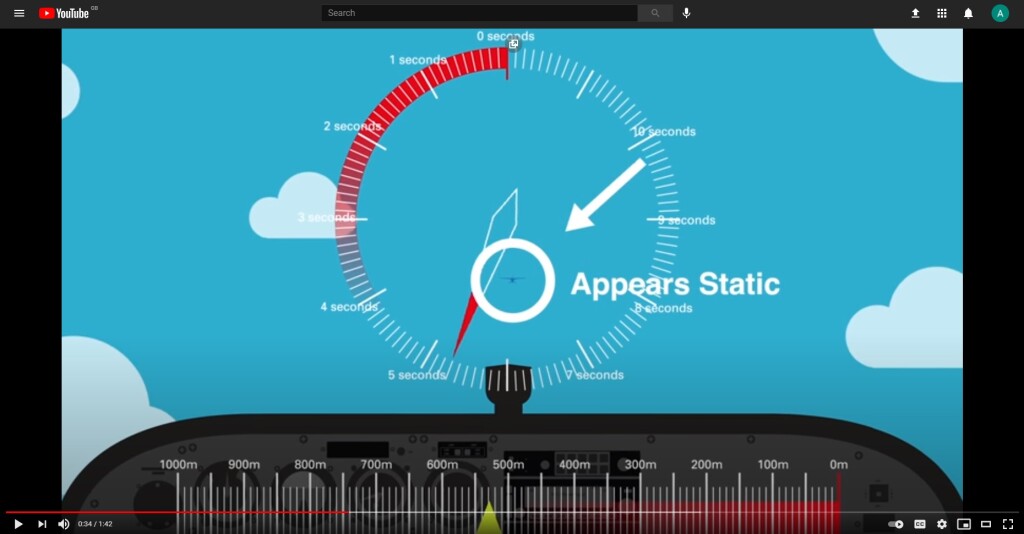
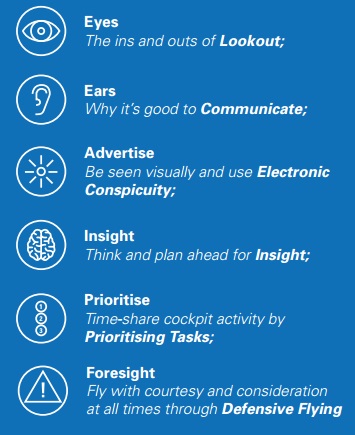
Recent Comments